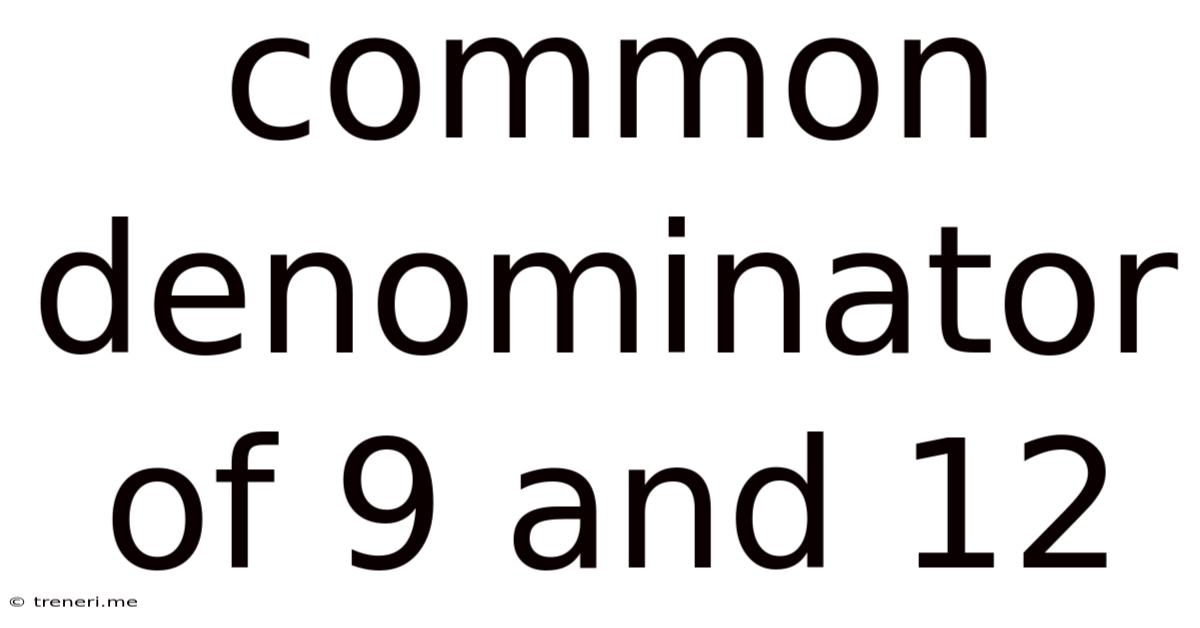Common Denominator Of 9 And 12
Treneri
May 14, 2025 · 4 min read

Table of Contents
Finding the Common Denominator of 9 and 12: A Deep Dive into Number Theory
Finding the common denominator of two numbers, such as 9 and 12, is a fundamental concept in mathematics, crucial for adding and subtracting fractions. While seemingly simple, understanding the underlying principles unlocks a deeper appreciation of number theory and its applications. This article will explore various methods for determining the common denominator of 9 and 12, delve into the concept of least common multiples (LCM), and discuss the broader significance of this mathematical operation.
Understanding Common Denominators
Before we tackle the specific case of 9 and 12, let's establish the core concept. A common denominator is a number that is a multiple of both denominators in question. When adding or subtracting fractions, we need a common denominator to ensure we are working with equivalent parts of a whole. For instance, adding 1/9 and 1/12 requires finding a common denominator before we can proceed with the addition.
Methods for Finding the Common Denominator of 9 and 12
Several methods can determine the common denominator of 9 and 12. Let's explore the most common and effective approaches:
1. Listing Multiples
The simplest method involves listing the multiples of each number until we find a common value.
- Multiples of 9: 9, 18, 27, 36, 45, 54, 63, 72, 81, 90...
- Multiples of 12: 12, 24, 36, 48, 60, 72, 84, 96, 108, 120...
Notice that 36 and 72 appear in both lists. These are common denominators. However, we're typically interested in the smallest common denominator, which makes our calculations easier.
2. Prime Factorization
A more sophisticated and efficient method involves prime factorization. This approach leverages the fundamental theorem of arithmetic, stating that every integer greater than 1 can be uniquely represented as a product of prime numbers.
- Prime factorization of 9: 3 x 3 = 3²
- Prime factorization of 12: 2 x 2 x 3 = 2² x 3
To find the least common multiple (LCM), we take the highest power of each prime factor present in either factorization:
- Highest power of 2: 2² = 4
- Highest power of 3: 3² = 9
Multiplying these together gives us the LCM: 4 x 9 = 36. Therefore, the least common denominator (LCD) of 9 and 12 is 36.
3. Using the Formula: LCM(a, b) = (a x b) / GCD(a, b)
This method uses the greatest common divisor (GCD) to calculate the least common multiple (LCM). The GCD is the largest number that divides both numbers without leaving a remainder.
-
Finding the GCD of 9 and 12: The divisors of 9 are 1, 3, and 9. The divisors of 12 are 1, 2, 3, 4, 6, and 12. The greatest common divisor is 3.
-
Applying the formula: LCM(9, 12) = (9 x 12) / 3 = 108 / 3 = 36
This confirms that the least common denominator of 9 and 12 is 36.
The Significance of the Least Common Denominator (LCD)
Choosing the least common denominator (LCD) is crucial for several reasons:
- Simplicity: Using the smallest common denominator simplifies calculations, making them easier to manage and less prone to errors.
- Efficiency: Working with smaller numbers leads to more efficient computations, saving time and effort.
- Standardization: Using the LCD provides a standard method for comparing and manipulating fractions.
Applications of Common Denominators
The concept of common denominators extends far beyond basic fraction arithmetic. It has applications in various mathematical fields and real-world scenarios:
- Algebra: Solving equations involving fractions often requires finding a common denominator to simplify the expressions.
- Calculus: Common denominators are essential in calculus operations like integration and differentiation.
- Chemistry: In stoichiometry, balancing chemical equations involves working with ratios and proportions, which often require finding common denominators.
- Engineering: Many engineering problems involve fractions and ratios, making the understanding of common denominators vital.
- Finance: Calculating interest rates and compound interest often involves working with fractions and decimals.
Beyond the Basics: Exploring Further Concepts
Understanding the common denominator opens doors to more advanced mathematical concepts:
- Modular Arithmetic: The concept of congruences in modular arithmetic builds upon the principles of divisibility and common multiples.
- Abstract Algebra: The ideas of greatest common divisors and least common multiples are fundamental in abstract algebra, particularly in ring theory.
- Number Theory: Finding the least common multiple is a key component in many number theory problems, including Diophantine equations.
Conclusion: Mastering Common Denominators for Mathematical Proficiency
Finding the common denominator of 9 and 12, while a seemingly simple task, illustrates fundamental principles in mathematics. Understanding different methods—listing multiples, prime factorization, and using the GCD formula—provides a deeper understanding of number theory and its applications. The ability to efficiently find the least common denominator is crucial for accurate and efficient calculations in various mathematical fields and practical applications. Mastering this concept lays a solid foundation for tackling more complex mathematical challenges. Remember, the seemingly simple concepts often hold the keys to unlocking more advanced mathematical understanding. By solidifying your grasp of common denominators, you're equipping yourself with a powerful tool for mathematical problem-solving.
Latest Posts
Latest Posts
-
Find The Distance Between Two Lines
May 15, 2025
-
How Many Cups Is 28 Fl Oz
May 15, 2025
-
How To Calculate The Length Of A Ramp
May 15, 2025
-
Cuanto Es 400 Ml En Onzas
May 15, 2025
-
How Much More Days Till December
May 15, 2025
Related Post
Thank you for visiting our website which covers about Common Denominator Of 9 And 12 . We hope the information provided has been useful to you. Feel free to contact us if you have any questions or need further assistance. See you next time and don't miss to bookmark.